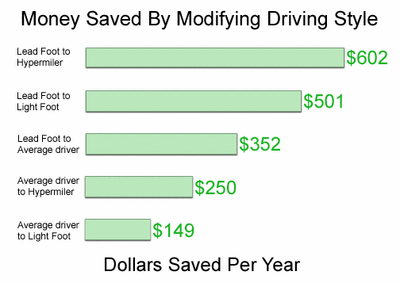.
Tips for all drivers
Drive conservatively
Aggressive driving (speeding and rapid acceleration/braking) can lower your gas mileage by as much as 20%.
Glide to stops and accelerate slowly and evenly.
Drive consistently
Spend as much time at the same speed as possible. Mileage is worst during acceleration.
Use cruise control whenever possible, but only when the roads are flat.
Slow down
Each 5 miles per hour you drive over 60 mph can reduce your fuel economy by 10%.
Stay tuned up
Keep your engine running at its best, stick to all recommended maintenance intervals for things like spark plugs, spark plug wires, oils and filters.
Keep cool
Try to minimize the use of your air conditioning, especially in stop and go city driving. If you must run it, first drive with the windows open to get the extra hot air out, then make sure the AC is in recirculation mode (so it doesn't have to keep cooling incoming hot air) and set the temperature to something warmer than full cold.
On the highway, however, open windows do not impact fuel economy significantly compared to air conditioning, due to additional drag.
Don't sit idle
Idling gets 0 miles per gallon. Turn the engine off when stopped for extended periods of time, such as at a traffic light for one minute or longer.
Check your tire pressure
Keeping tires inflated to the recommended pressure can improve fuel economy by up to 5%.
Unload your trunk
The more weight you carry, the more energy required to move it.
De-clutter the exterior
Remove aftermarket bug and wind deflectors, and don't bother adding wings/spoilers, these things only add drag. If you have a removable roof rack, take it off when not in use.
Treat your automatic like a manual
When you're stuck in traffic or waiting at a long red light, drop your transmission into neutral so the engine doesn't have to strain against the torque converter.
Combine chores and trips
An engine runs most efficiently when warmed up. If possible begin with the furthest away stop (to maximize warm-up time), then make additional stops on the way back.

